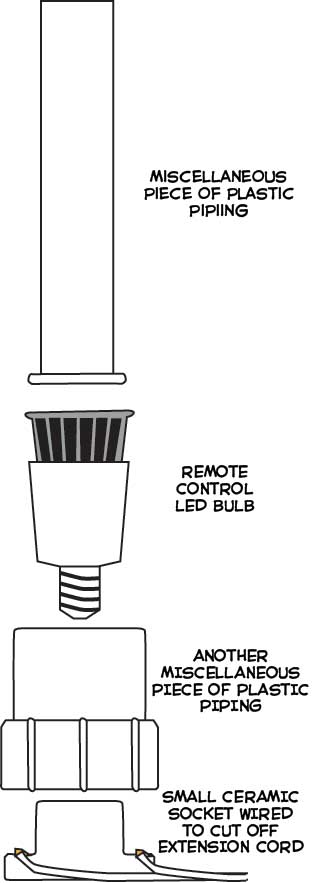This is our latest lamp, based on a remote controlled LED.
|
How to Make a Remote Control LED Lamp |
This is our latest lamp, based on a remote controlled LED.
|
| If you've been over at ThinkGeek lately you may have noticed that they are selling a multi-color LED that fits in a standard light socket. Even better, it comes with a remote control. If you want to add a bit of color to your life, you can screw one into a lamp or a ceiling socket. Alternatively, you can make your own remote controlled, multi-color lamp with maybe $10 worth of stuff from your local hardware store. We used to have one of those multi-color LED candles, but it lost its green, and they don't manufacture them anymore, so this was a perfect opportunity. |
 |
Our local hardware store has all kinds of PVC plastic piping in various sizes, shapes and thicknesses. Since you aren't plumbing, bring the LED bulb with you and see what looks good. The bulb is about 2" in diameter at its broadest, so 1 1/2" and 2" piping parts are about the right size. The upper miscellaneous piece was part of a toilet tank repair kit. The important thing is that it is made of relatively light PVC, so it is translucent. It is also broad enough in diameter to cover the face of the LED bulb. The lower miscellaneous piece was some random joint. It has a screw thread inside, though this doesn't matter with regards to the lamp. The ceramic socket was just a small, white ceramic socket. The advantage of this one is that it didn't have any exposed copper on its bottom, so it could rest on an ordinary surface. You could use one of those standard, nail them to the ceiling of a construction site, sockets, but they are a bit clunky looking. You could also rig up your own base from a ceramic or plastic socket and attach it to a piece of tile or the like. The wiring consists of an extension cord with the multi-plug part cut off. You obviously have to leave the wall plug part intact so you can plug it in. This is usually cheaper than buying some wire and a plug and fussing. A bit of quick work with a pair of wire strippers and a screwdriver is all it takes. You don't need a switch. The LED bulb has a remote control! What holdsit together? That's easy, the magic of a glue gun. Glue gun glue is also a fairly good insulator, so you can use it to cover any exposed wires. Glue the lower miscellaneous piece to the socket. Screw in the bulb. Test it. Then glue the upper miscellaneous piece to the face of the bulb. There you are, a lamp in maybe ten minutes, and it's not just a lamp, it has multiple colors and a remote control. (It probably has more computing power on board than the typical Fortune 500 company back in the 1960s, so aren't we all spoiled today.) |
This is another fine lighting option from Kaleberg Labs.
If it doesn't meet your lighting needs, you might consider our K'Nex based kinetic lamps and our softly illuminated Kenner's Girder and Panel lamp.
© Copyright Kaleberg Symbionts 2008